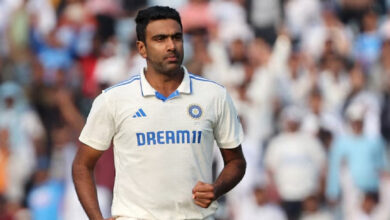WTC Final: India wake up, but Australia refuse to blink

The embers of an Indian fightback flickered, though it never sparkled into a wildfire that consumed the Australians. So complete has been the domination of Pat Cummins’ men in the first two days that even if they had to navigate through tough passages on the third day they are still the runaway favourites to hold aloft the heavy mace, come the day of judgement. In isolation, Day Three sped along rapidly, produced scraps and moments, was more evenly balanced, was stitched with combative batting, hostile bowling, and episodes of both the spectacular and comical fielders, making it the most engrossing of all three days. It, though, ended on the same sombre note for India, as had all previous evenings. The lead of Australia is sitting on 296, six more wickets are in the shed for them to make India’s fourth innings target soar out of their bounds on a surface fast acquiring devilish traits. The reality was screaming all along this Test — once India had wasted the new ball on Day One, let Australia put on 469 and self-destructed to 71/4, the shores of victory had sunk beyond the horizon. The stoic resance of Ajinkya Rahane and Mohammed Siraj could only suspend the reality for some time, could only infuse some joy for the hordes of the raucous Indian supporters, and could only fire warning-memos to Australians that there is no place for let-ups in this game, there are still areas to tighten up in their ambition to rule Test cricket . Try as the Rahane and Siraj did — one a study of boiling calmness, and the other a portrait of bounding hostility — their efforts had a tragic ring to them. Rahane was always going to end up as the unfortunate hero, he would fall 11 runs short of a Bollywood-scripted comeback hundred. Siraj, all bark and bite, would not walk back with a five-for. But the pair managed to hurt and harass Australia, instigated makes and moodiness, and for some made them look like the hunted.
Stumps on Day 3 of the #WTC23 Final!
Australia finish the day with 123/4 as #TeamIndia scalp 3️⃣ wickets in the final session 👌🏻👌🏻
Join us tomorrow for Day 4 action!
Scorecard ▶️ https://t.co/0nYl21pwaw pic.twitter.com/NzVeXEF0BX
— BCCI (@BCCI) June 9, 2023
Under the bright blue skies, with a bright red ball, Siraj raised hell. His plan to the left-handed opening pair of David Warner and Usman Khawaja was ridiculously simple. Nibble the ball across them from round the stumps. Most balls with slant across the angle, some would seam away (both with the wobble and upright seam), some would hold the line in their journey. Similar were his methods in the first innings too, but here plans were wedded to precision of length and line, allied with anger and aggression. Some bowlers bowl well when they are angry; Siraj seethed in anger and unleashed fury on them. He nailed Warner with a delicious out-swinger, with the score on two. Buoyed, he made Labuschagne walk through a crucible of fire. Twice, his length balls shook up to ram his gloves. The bat would fly out of his hands, he would grimace in pain.
It did not help Labuschagne that he was batting a yard outside the crease. He was safeguarding against swing but at the compromise of efficiency against short-pitch bowling. Siraj would throw a blood-shot stare, Labuschagne would stare back passively. Later, the nip-backer bounced and hurried him, blasting the torso. He plunged to the heavily-indented crease. But Labuschagne survived; Siraj could not add another wicket to his reger. As intimidating as the spell was, it was fruitless and one of irrelevance. As he walked back to his outpost in the deep, forlorn and weary, you could see the game slipping further away from India.
Ajinkya Rahane was #TeamIndia’s 🔝 performer from the first innings for his classy 89 off 129 deliveries in the #WTC23 Final 👏🏻👏🏻
A look at his batting summary 🔽 @ajinkyarahane88 pic.twitter.com/laDW1Nn66U
— BCCI (@BCCI) June 9, 2023
Then, Siraj is no miracle worker like Jasprit Bumrah. In Bumrah’s absence it was always going to be a collective effort that was going to win India games abroad. On the dustbowls of home, his absence was barely felt, but in England, where he has produced some of his most magical spells, he was dearly missed. Siraj must have felt alone, as the usually reliable Mohammed Shami was woefully erratic. Umesh Yadav was not consently sharp, age and injuries diminishing his prowess; Shardul Thakur was never the man to run through sides. He at least wore blows on his body when batting with Rahane. A rethink and revision of India’s pace-bowling personnel and strategies looks imminent.
So should they on the batting front. For, depending on just one batsman to save you all the time is not just a risky ploy, but a myopic one too. Ir’s not an one-off instance. In the home series against England and Australia, the lower-order had glossed over the cracks at the top on numerous occasions. How often has the spin all-round trio of Ravindra Jadeja, Ravichandran Ashwin and Axar Patel proved the difference, more so in the absence of Rishabh Pant.
The Oval track was not a fiendish grass-swamp either. Rahane demonstrated this with judicious stroke-play. A refined technique helped, but here was somebody playing as close to his body as possible. He was slapping the wide balls, not trying to steer the ball to third man (and getting chopped on), not stabbing at the ball or lunging into drives. It was the closest he had played to his body than in any other innings of his career (1.49m), according to CricViz.
FIFTY!
A gritty and important half-century @imShard here at the Oval 🫡🫡
His 4th in Test cricket.
Live – https://t.co/0nYl21oYkY… #WTC23 pic.twitter.com/dsk4T0muap
— BCCI (@BCCI) June 9, 2023
The setting too was perfect for Rahane — on a comeback, his team neck deep in crisis, and the phalanx of Australian bowlers invulnerable. Showered with slices of fortune— a no-balled lbw, dropped catches — he prospered in as only a way as he could. As with most knocks of his, the punched cover-drives stood out, but he perished at the wrong time. Resolute as he was for most of his knock, the slash of the wide Cummins ball could have been avoided. More so as he had support at the other end — Thakur had weathered a test of survivability and was starting to impose. It was the start of a new session, and a more cautious approach would have benefitted him and his team.
But that in the end has been the difference between the sides — Australia seized their moments, while India did not. Australia pressed and probed; India snapped too meekly. Winning just two passages of the game, more often than not, don’t win you games. Test matches ex not as isolated chapters of a book, but it’s a narrative spread across several chapters. It had no place for one-day fightbacks or heroes.





